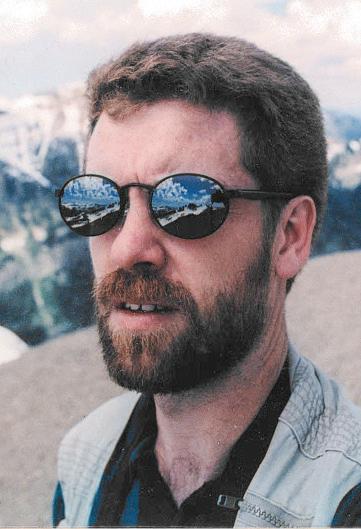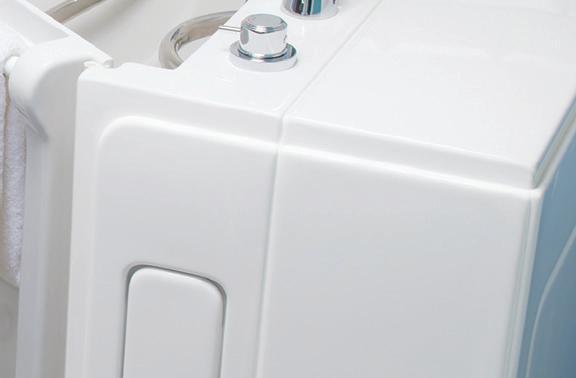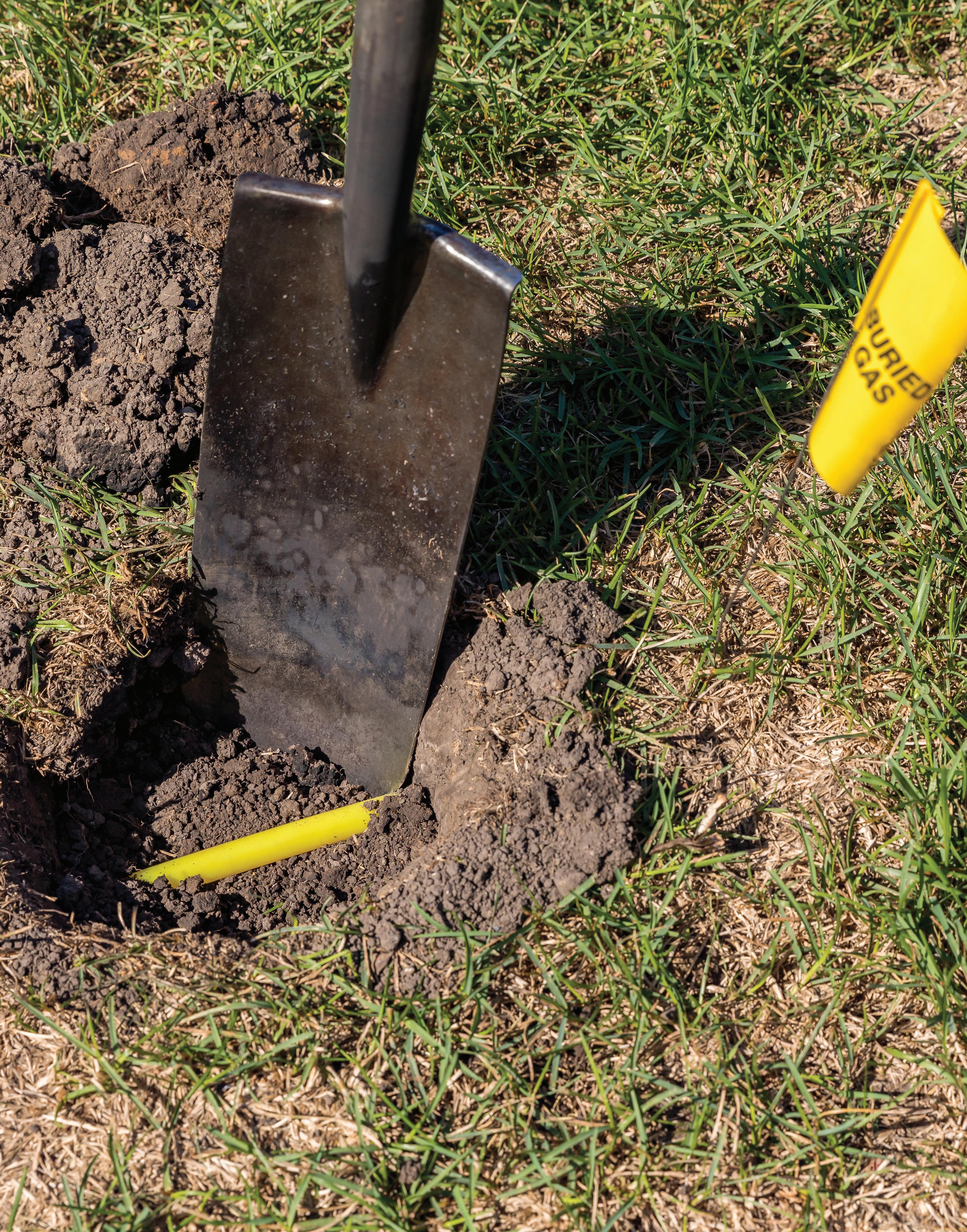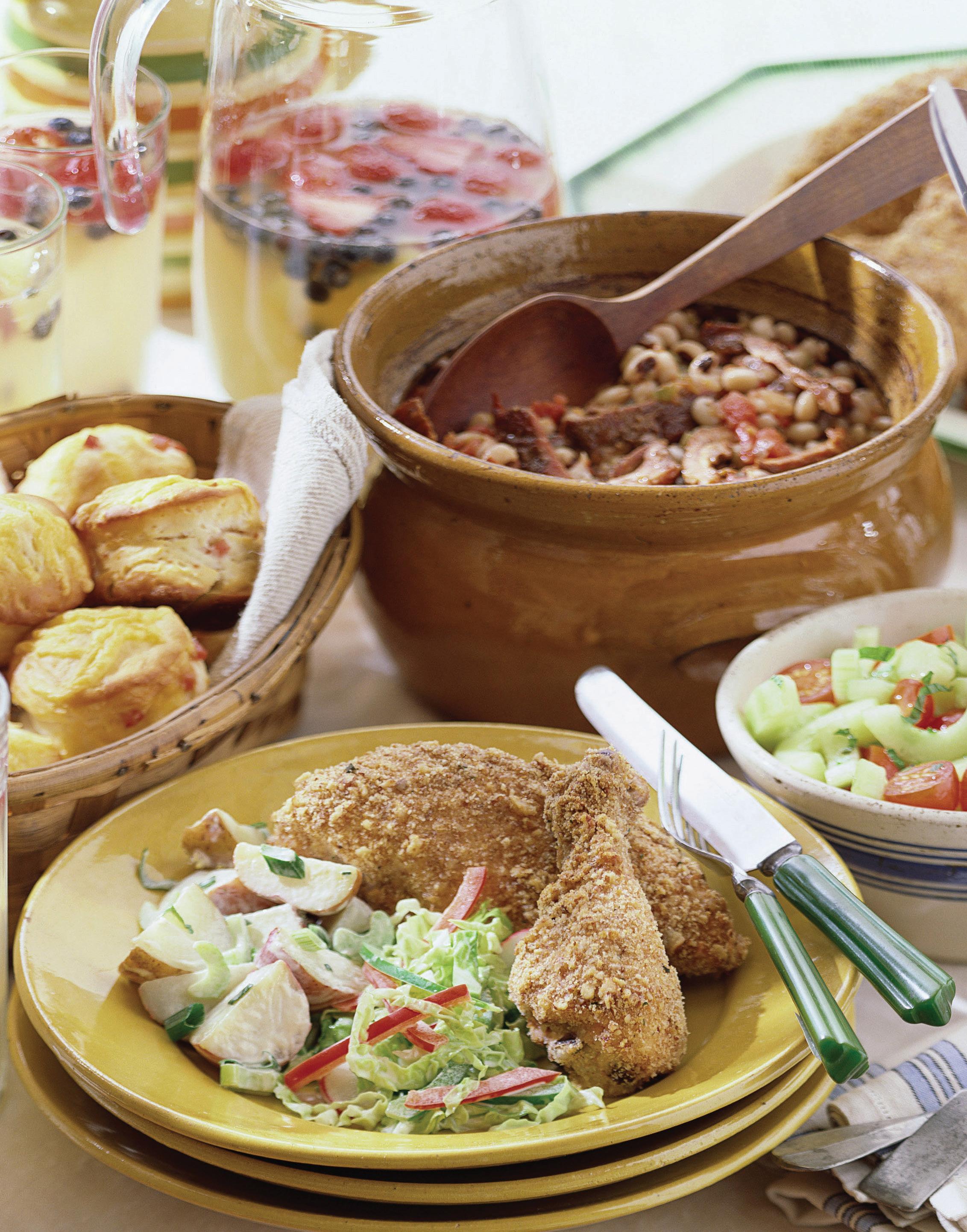LANE ELECTRIC
NOVEMBER 2024



Page 4


Centuries ago, Persians, Tibetans and Mayans considered turquoise a gemstone of the heavens, believing the striking blue stones were sacred pieces of sky. Today, the rarest and most valuable turquoise is found in the American Southwest–– but the future of the blue beauty is unclear.
On a recent trip to Tucson, we spoke with fourth generation turquoise traders who explained that less than five percent of turquoise mined worldwide can be set into jewelry and only about twenty mines in the Southwest supply gem-quality turquoise. Once a thriving industry, many Southwest mines have run dry and are now closed.
We found a limited supply of turquoise from Arizona and purchased it for our Sedona Turquoise Collection . Inspired by the work of those ancient craftsmen and designed to showcase the exceptional blue stone, each stabilized vibrant cabochon features a unique, one-of-a-kind matrix surrounded in Bali metalwork. You could drop over $1,200 on a turquoise pendant, or you could secure 26 carats of genuine Arizona turquoise for just $99
Your satisfaction is 100% guaranteed. If you aren’t completely happy with your purchase, send it back within 30 days for a complete refund of the item price.
The supply of Arizona turquoise is limited, don’t miss your chance to own the Southwest’s brilliant blue treasure. Call today!
Jewelry Specifications:
• Arizona turquoise • Silver-finished settings Sedona Turquoise Collection
A. Pendant (26 cts)
B. 18" Bali Naga woven sterling silver chain $149 +s&p
C. 1 1/2" Earrings (10 ctw)


November 2024
• Volume 72, No. 11
CEO Michael Shepard
SENIOR VP OF CONTENT Leon Espinoza
EDITORIAL DIRECTOR Mike Teegarden, CCC
DEPUTY EDITORIAL DIRECTOR
Noble Sprayberry
SENIOR EDITOR Jennifer Paton, CCC
ASSISTANT EDITORS Chasity Anderson, CCC; Victoria Hampton, CCC; David Herder, CCC
ASSOCIATE EDITORS
Valeri Pearon, Nina Todea
PUBLICATIONS PRODUCTION SR. MANAGER
Elizabeth Beatty
SENIOR PUBLICATIONS COORDINATOR
Alyssa McDougle
Ruralite (USPS 397-460) is published monthly for members for $5.43 per year, plus postage, by Pioneer Utility Resources Inc., 5625 NE Elam Young Pkwy. Ste. 100, Hillsboro, OR 97124—a not-for-profit Oregon cooperative corporation—to serve the communication needs of 46 consumer-owned electric utilities in Oregon, Washington, Alaska, Idaho, Nevada and California. Preferred periodical postage paid at Hillsboro, Oregon, 97123 and additional mailing offices. © 2024 Pioneer Utility Resources. All rights reserved. Reproduction in whole or in part without written permission is prohibited.
Postmaster: Send address changes to Ruralite, 5625 NE Elam Young Pkwy. Ste. 100, Hillsboro, OR 97124-6454
HOW TO CONTACT RURALITE
Subscription services:
Nonmember subscriptions $15 (U.S.) per year; $25 per year (foreign). Prepayment required. Allow 4-8 weeks for first issue. Be sure to identify which local edition you want to receive.
Address Changes:
Utility members, contact your local utility. Subscribers, call us at 503-357-2105 option 3 or email mailingdept@pioneer.coop.
Back issues:
Back issues and extra copies $3. Prepayment required. Supply is limited. Be sure to identify edition, month and year. Call first if ordering back issues to check availability.
To contact Ruralite: Ruralite magazine is published by Pioneer Utility Resources.
P.O. Box 1306, North Plains, OR 97133-1306; 503-357-2105; email: info@pioneer.coop. For more information, visit www.pioneer.coop.
DISPLAY ADVERTISING INQUIRIES
American MainStreet Publications
611 S. Congress Ave., Ste. 504 Austin, TX 78704
800-626-1181 or 512-441-5200
See that young guy on the left? That is me more than 30 years ago on my first trip for this magazine. I was ambitious, energetic and excited about embarking on a new career as an assistant editor at a magazine, my dream job. Today, I am writing my last column before retiring at the end of the year. What a glorious ride it has been.


During my time, I have traveled to places I only dreamed of seeing. I spent a week on a tug-and-barge off the coast of Alaska. I traveled to Guatemala, where I spent three weeks photographing lineworkers bringing electricity to a small community for the first time. I have been in small, rural Alaskan villages only accessible by plane, boat or sled. I have covered forest fires in Oregon and a plucky young barrel racer in Arizona who is paralyzed from the waist down. I’ve been hoisted 70 feet in the air in a bucket truck and flown in a hot air balloon. And I have attended countless utility annual meetings, talking with readers like you.
In the past few years, I’ve received many calls, letters and emails from you. Some of you were grateful for a story or hopeful I would publish

For supplemental and interactive content, search @Ruralite on your favorite social media sites.
one. Others took exception to something in the magazine or found an error you thought I should know about.
A few of you sent me milkweed seeds in my quest to create a monarch butterfly habitat.
I appreciate your passion about what is printed each month. You have kept me on my toes. Thank you. My success here is due to two factors: The support of my wife and kids when I worked long hours and traveled at inopportune times; and through the support of a wonderful team of friends who do amazing work every day. I wish I had room to list each one of you, but you know who you are.
Starting next month, Chasity Anderson takes over duties as editorial director. She is a friend and someone I have great respect for. I know she will serve you well.
And now, friends, I say goodbye. I hope you continue to be faithful readers.
Farewell,
Mike Teegarden Editorial Director

Air Force veteran continues to lead in local and state VFW Up Close, Page 10
Volunteers build beds so no child has to sleep on the floor


Soaring by the Sea Foundation gives veterans and plane enthusiasts one-of-a-kind experiences
By Craig Reed
The PBY Catalina airplane is credited with rescuing many airplane pilots and ship crews who were adrift in water during World War II. It’s also credited with sinking a German U-boat.


a flying boat hull, retractable tricycle landing gear and retractable wing-tip floats. The PBY patrol bomber could land on land and water, allowing the aircraft and its crew to perform water rescues.
The P-40 Warhawk is an American single seat fighter-bomber that first flew in 1938 and was used by the United States and most Allied nations during World War II. It was known for its durability and was used for ground attack and bomber escort.
The histories of these two types of planes and their many adventures are shared today through a 1943 PBY and a P-40 that are owned by the Soaring by the Sea Foundation. The foundation and its planes are based in a hangar at 29030 Hollis Lane near the Eugene Airport. There are only a few of these operable planes that still exist today.
“It’s an honor to carry the history forward of this plane,” says Jennifer Pfaff. “One of our goals is to get as many veterans on board, especially those who served on a PBY and the World War II




finding a PBY after serving in the U.S. Marine Corps from 2013 to 2017. He was in France in late 2018 when he found a man who had a collection of a dozen aircraft and wanted to sell off the larger ones. One of those was
A group of anonymous donors bought the plane in 2019. After the Soaring by the Sea Foundation was established in 2020, the
“A lot of the plane was OK, but it needed some new equipment
After six weeks of maintenance on the aircraft and Coy planning out a route, the plane lifted off for the journey to Oregon in June 2019. Stu sponsored the trip, and six people, including Coy and three PBY-certified pilots, made the trip.
“Stu was standing there with thumbs up in the air,” Jennifer says of the landing in Eugene. “Hundreds of people welcomed the plane. It was an emotional day. I don’t think there was a dry eye in the house.”
Over the next few days, four flights a day were made, giving veterans and those interested the opportunity to reacquaint themselves with the plane or to experience it for the first time.
“When I got on the airplane, it resonated with me that parents had no idea what their sons were doing during that war,” Jennifer says. “What sons went through at that time, that got my heart. It made me fall in love with this plane. And I got to have my son come home with it.”
Dennis Egts, a Eugene resident, visited the plane and took a look inside it.
“I’m in awe of the construction of the plane,” he says. “I looked at the signatures on the plane’s wall of the people who served on it.


and the funding to keep them air-worthy. Parts can be made from original drawings, but they’re expensive.
“We’re there to share the history, to keep them in the air and to share with people.” n

Think like a lineworker to winterize your home and prepare emergency measures before the chill of the season sets in
By Nina Todea
When winter temperatures drop and storms hit, it can be challenging to stay warm and safe. Extremely low temperatures, high winds and heavy snowfall can lead to power outages. During a power outage, utility crews work as quickly and safely as possible to restore your power, but it still takes time.
Lineworkers, who brave the elements to keep electricity flowing, have key insights to storm readiness and how to keep their families ready come winter. Think like a lineworker, and take proactive measures now to ensure your home remains safe and prepare your family to weather any storm coming your way.
Although the extremity of winter weather varies from one region to another, no area is immune to weather-related events.
In Northern Idaho, where Foreman Cliff Miller has been a lineworker with Clearwater Power Co. for 29 years, winters are cold with significant snowfall. Cliff’s experiences as a lineworker
influence his lists of tasks inside and outside the home.
He recommends ensuring your heating system is reliable and efficient. Start with scheduling a maintenance check for your furnace or heating source. A professional can clean filters, check for potential hazards and ensure your system operates smoothly.
If you rely on electric heat, have a backup heating option in place—such as a generator, fireplace or wood-burning stove—to stay warm during prolonged outages. Remember that fuel- and woodburning heat sources should always be properly ventilated.
Insulating your home and weatherstripping around doors and windows can prevent heat loss and keep your space more comfortable, with and without power. For a more budget-friendly option, consider thermal curtains to help retain warmth.
Outside the home, Cliff recommends disconnecting all hoses from bibs and hydrants, draining them and putting them away, as well as draining and winterizing
campers and boats to store them for the winter. Installing stock tank heaters and filling propane tanks before winter weather hits is also beneficial.
When a storm hits and a power outage is likely, unplug all sensitive equipment so it isn’t damaged in a potential power surge.
An effective winter emergency kit is crucial for any household. Stock up on essentials: nonperishable food items, bottled water and medications. The Centers for Disease Control and Prevention recommends families have at least a three-day supply of food and water per person.
“My home winter emergency kit includes water, freeze-dried meals, flashlights, a jet-boil or other backpack camping stove for heating water and food,” Cliff says. “Water and freeze-dried meals have served us best. I also always keep flashlights, blankets, a winter coat, a stocking hat and gloves in the vehicle during winter months.”
Warm clothing, such as gloves, hats and thermal layers, can protect against the

biting cold if you need to venture outdoors to tend to animals or assist neighbors.
For Cliff, layering is key. Multiple thinner layers will keep you warmer than one thick layer. Consider adding safety gear, such as helmets or high-visibility vests, to your kit.
“Good warm, waterproof boots are necessary for harsh winter conditions,” Cliff says. “I dress for the worst and hope for the best.”
Also include within reach a shovel for clearing snow and an ice scraper for your vehicle.
Braving the weather is often unavoidable. When you must venture out, tread carefully, whether on foot or in your vehicle.
If you’re shoveling snow, stay hydrated and take regular breaks to maintain alertness. Lineworkers know cold weather can be deceptive; you might not realize you’re getting fatigued or dehydrated until it’s too late.
“To stay focused and alert when out in inclement weather, especially for longer periods, it is important to keep your core temperature up, rest when you can and then caffeinate—in large quantities—when you can’t,” Cliff says.
If driving, check your tires prior to the winter season so your vehicle is in good condition and can manage icy roads. Be aware of others—including lineworkers, who might be working to restore power— drive slowly and remove potential distractions. If you encounter downed lines, always assume they are live. Steer clear of the lines, and call your utility to report the damage.
Remember that your safety, and the safety of your community, is more important than arriving early to your destination. Always check the weather forecast to know what to expect.
Winter weather can be unpredictable. By understanding the risks associated with winter storms and taking steps to mitigate those risks, you can ensure your family stays safe and warm. n
By Scott Flood
Moments ago, a stray bolt of lightning connected a menacing cloud with a power pole about a mile east of your home. Your lights flickered briefly before going out. Things become eerily quiet as all your home’s devices equipped with motors and fans stop providing their constant symphony of background noise.
You’re experiencing a power outage, so you reach for your phone and call your electric utility. Good move. Sometimes, consumers don’t call because they assume their neighbors will. However, the more who call, the more quickly the utility is able to pinpoint the outage location.
Back at the office, the utility’s grid system operator noticed the sudden pause at the moment 300 million volts of lightning danced around a transformer, and they’re able to triangulate the location of the outage. The system estimates around 500 consumers are in the dark as a line crew tosses their dinners aside and steers their trucks in that direction.
Thirty minutes later, the lineworkers slowly drive along a stretch of road, keeping one eye on traffic while inspecting every pole, wire and transformer. In another eight minutes, they stop and step out for a closer look. The mystery is solved with one glance at the burn mark across the surface of the transformer. Readying the truck and ensuring it’s safe, they move closer.
If you watch the lineworkers, you might mistakenly assume they’re not motivated. After all, you’re dealing with a power outage you want to end as soon as possible. But there’s a good reason the lineworkers aren’t rushing or running around.
Power lines carry high-voltage electricity. It’s safe when all elements of the system are in good working order, but it’s potentially deadly when that’s not the case. Lineworkers approach what they do deliberately, efficiently and—most of all—safely. Every action is carefully planned so they can spot potential hazards. They follow standard procedures and safety requirements to ensure repair is effective and sound. The work may take a little extra time, but it means they’ll make it home safely at the end of the day (or night).
Less than an hour after finding the cause of the outage, the lineworkers load their tools and gear back onto the trucks. This time, the problem was easy to spot, the repair was fairly straightforward, and the weather cooperated. But no two outages are exactly alike. The next could be in severe weather or on a remote segment off the main road. It could involve a fallen tree that needs to be cut with chainsaws or a broken pole that needs to be replaced.
Driving back to the utility, the lineworkers watch the passing homes and smile. The warm glows coming from the windows means the power’s back on again.
Lightning isn’t the only threat to the electric system. Outages can occur from a variety of causes, including fallen trees, vehicle crashes, extreme weather and even curious critters, such as squirrels.
Electric utilities invest in technology and equipment designed to protect the power grid and prevent outages from plunging your home into darkness. But when the power does go out, lineworkers put themselves at risk to return your life to normal.

Shelby Sanford has been a valued Lane Electric team member for more than six years. In that time, she has held four different positions.
Most recently, Shelby has served the cooperative as an engineering technician, known as a staker. In this role, she’s responsible for technical duties required in the design and preparation of work orders, service orders, service requests, easements and agreements associated with extensions and maintenance of the transmission and distribution system.
Was engineering technician always your goal?
“During my first year at the cooperative, I attended the Northwest Public Power Association’s two-day course on operating an electric utility, which started me on my journey.
From there, I wanted to learn as much as possible about Lane Electric’s construction and how we deliver power to our members. I kept requesting training and asked a ton of questions. The engineering department and our linemen are some of the best teachers and love to pass on their knowledge. My previous roles as a member services representative and joint use specialist/operations representative gave me the foundation to transition into staking.”
Utility staking is the process of marking the physical locations of new utility lines and structures on the ground.
“It is a critical part of construction that ensures utilities are installed correctly,” Shelby says.
Joint use refers to partnerships with cable and telecom companies and municipalities that attach to Lane Electric utility poles and pay a fee to the utility for infrastructure use.
What do you like best about your current position?
“In this position, each day brings new challenges and opportunities to learn. One day, you can be up in the South Hills trying to devise a plan to underground our power lines, and the next day, you might spend out in Oakridge working with contractors and electricians to bring power to homes being built. It’s always different.”
Are there any job highlights you’d like to share?
“As a staking technician, you get to see places in our service territory that you didn’t know existed. Providing rural power has its challenges, but I feel we are lucky to work in the Pacific Northwest environment.
I’d encourage our youth to explore career paths in their local utilities. There are some great opportunities to give back to your community and provide vital services. Lane Electric also offers some great scholarship opportunities.” n
Visit laneelectric.com/headlines/scholarships for details about Lane Electric scholarships.















































By Melanie Jones
“It’s not a man’s world,” Carol Kacal says.
The Air Force veteran has been breaking glass ceilings for decades.
For 20 years, Carol served her country. Her service included a six-month stint in Turkey, where she held a leadership role. She says meeting all the different people and making lasting friends was a favorite part of her service.
the Air Force seemed like a good fit. She signed up at 18 and got her wish.
Along with assignments stateside in Missouri, Arizona and Colorado, Carol served in Guam, Germany, Korea and Turkey before her last assignment in Alaska. She liked it so much that she stayed after putting in her 20 years.
Carol says one of her most interesting stops was in Turkey, where she oversaw supplies and equipment coming in and out of the country for the Army and Air Force.



in and take advantage of the different opportunities provided,” is her advice for anyone considering serving in the military.
But Carol has specific words of wisdom for women.
“Females need to work alongside others, not behind or think they are better or worse,” she says. “The big thing is learning to be a team.”
This holds true in the military and out.
Carol earned the right to join the VFW while serving in Korea. In the past, many women veterans chose to join the women’s auxiliary instead of the VFW itself, even though they had served in the military. Now, not only are more women joining, but more are serving in leadership roles.
“Joining the VFW brings camaraderie among people who have been in military situations together,” Carol says. “We pull together and are able to stand up for veterans’ rights that we’re promised when we sign the dotted line.”
Carol serves as quartermaster for VFW Post 10029 in North Pole.
“I believe in helping the veterans and their families,” she says.

One thing Carol is always proud to do is ensure there are flag lines for soldiers to walk through when they return home. She says some people at airports seem to think they are blocking servicemen and women from seeing their families when they get off their planes, but that’s not the intent. Organizers want to ensure that when service members step into the airport returning from their stations, all they see is a wall of U.S. flags.
Life isn’t all about the VFW, though. Serving in accounting and budgeting in the Air Force prepared Carol for her current job as an accounting assistant at Design Alaska.
There were a few struggles when she first left the military, though. For one thing, deciding what to wear was a hassle after 20 years of wearing a uniform almost every day. Another was keeping track of time.
“Now I work on an hourly basis, not on call 24/7,” she says.
Veterans Day is special for Carol. She and her veteran husband of 19 years, David, work with a second grade class
that holds a special program for veterans each year. They previously held the event at the VFW post, but it grew so large, they must hold it at the Moose Lodge in Fairbanks.
Last year, about 75 students performed a program for about 20 or 30 veterans, with parents and others in attendance. Recently, the students presented veterans with a flag with all their handprints on it.
Carol isn’t sure why there are so many women veterans in Alaska—it’s tied with Virginia for the greatest proportion—but she does know there are many dualenrollment couples in the state, meaning both spouses served in the military.
Regardless, Carol loves calling Alaska home and enjoys camping with David and playing with their cat and dog. The couple have three children and six grandchildren. When she’s not outside, working or helping other people, Carol enjoys doing puzzles on her computer and encouraging other women to join VFW.
“You have that right just as much as (men) do to be a comrade,” she says. “We have served side by side.” n


By Ginger Meurer
A joyful chorus from excited children greets the chapter members of Sleep in Heavenly Peace Nye County, Nevada, as they deliver seven beds to a Pahrump home. The number is just one shy of the organization’s record.
“When we came, they had nothing,” says Nye County Chapter President Carmen Murzyn. “Tonight, they all get to sleep in their own beds.”
Volunteers hauling headboards, railings, mattresses, bedding and tools stream in the door and up the stairs—home to children ranging in age from 6 months to 15 years old. The house is empty except for a television, a camping mattress and a few blankets.
The children’s mother said they moved from Las Vegas in search of a better job and more affordable housing. Her previous landlord wanted $3,000 a month for their apartment.
“I finally gave up and said, ‘I can’t afford it,’” she says.
Without a truck or funds for the move, the family left most of
their belongings behind and started over in Pahrump.
Chapter Delivery Manager Steve Filarowski and Chapter Build Manager Jim Murzyn—Carmen’s husband—assemble the wooden beds with power tools.
“They’re so basic, but they’re built well,” Jim says. “They’re solid. In this case, it’s the only piece of furniture in the house, but a lot of times they’re the nicest piece of furniture in the house.”
Jim and Steve say the basic components of the beds make them easy to assemble and sturdy.
“If we ever have an earthquake, I’m getting under one of these,” Jim says.
“They’re really built to last,” Steve adds.
Interested children can assist with assembly. On this day, only the oldest braves the screech of the power tools. Jim and Steve help her safely guide the screws into her bunk.
“Don’t be afraid of it! You’re doing good,” Jim says as she pushes the driver trigger. “It just makes noise.”
Once the beds are up, Carmen and volunteers Marjorie


Washington and Charmayne Fazackerley help the children choose bedding. They unroll mattresses and teach them how to make their beds.
Deliveries like this tap the talents of Sleep in Heavenly Peace volunteers in more than 300 chapters in four countries united by one mantra: “No kid sleeps on the floor in our town.”
SHP founder Luke Mickelson says his first delivery in December 2012 melted his heart and left him resolved to do more. He built a set of bunks with a young men’s church group for a family in their Twin Falls, Idaho, congregation. After that, he built a bed with his family and delivered it to Haley, a 6-year-old girl who was in a new home with her mom after being homeless and sleeping in the backseat of their car.
“We went into little Haley’s bedroom, and there was a pile of clothes in the corner, and that’s what she slept on,” Luke says.
Haley’s joy and her mother’s tears of relief were eye-opening. Back then, it took hours to build a bed, but Luke realized there was nothing more worth his time.
“We ended up doing 22 beds before Christmas that year,” Luke says. “It was awesome.”
The next December, he got more people involved. In 2014, he set up a nonprofit because people wanted to donate to the cause. In 2015, Luke and his friend, now SHP Executive Director Jordan Allen, decided instead of just building at Christmas and for a few
Eagle Scout projects here and there, they should host builds all year. There were 15 build days that year.
Soon, SHP got calls from volunteers from Minnesota to Maryland who wanted to build beds in their hometowns. So, they flew people into Idaho to train them and help them form new chapters. By the end of 2017, they had chapters in five states and more on the way.
That’s when Mike Rowe of TV’s “Dirty Jobs” fame featured
Sometimes you have to be willing to challenge yourself to do more than you think you can do.
—Jim Prior, co-president of the SHP Eugene Chapter
them on his “Returning the Favor” Facebook Watch series. Mike leveraged community support for a rent-free warehouse for SHP for three years.
“But the biggest thing that came from that is we were viewed by 10 million people,” Luke says.
The episode aired Feb. 12, 2018. SHP put together an application for those wanting to start chapters.
“In the first year, we had like 2,000,” Luke says. “A crazy amount.”
SHP swiftly boomed from seven chapters to more than 120. Apart from a slowdown during the COVID-19 pandemic, SHP has consistently added 40 to 50 chapters a year.
Prospective chapter presidents must go to a build and prove they have enough community support to keep their chapters going. Then they fly to Lehi, Utah, for training.
Jim Prior, who serves as co-president of the SHP Eugene Chapter alongside his wife, Jeanette, says training is intense. They’d been involved in SHP for more than four years, so they felt like there was much they understood—but the training gave them much more to learn.
“It was still kind of like drinking from a fire hose,” Jim says. “Even though we knew the general concept of what was going on.”
The Priors took over when Eugene Chapter founders Bryce and Connie Jonas decided to step back a little over a year ago. No one had volunteered to take over, and the Priors



didn’t want to see the area’s needs go unmet.
“I thought, ‘Sometimes you have to be willing to challenge yourself to do more than you think you can do,’” Jim says. “Nobody was really stepping up. And it had been such a great charity. It really gives a hand up and not just a handout to families. So, I said, ‘Welp, let’s keep this going.’”
Jeanette was on board, too.
“Jim and I thought about it and did a lot of praying,” she says. “We didn’t really want to see it go away. We believe in what it does and how it helps kids, and just to see the smiles.”
Jim says raising funds isn’t hard. Once he is in front of an audience, the idea of helping children sells itself. Plus, the dollars raised stay in town. Other than 10% routed to the national headquarters for overhead such as insurance, logistics and website maintenance, every penny raised stays with each local chapter and goes directly into beds for kids.
Luke says only about 4% of the national money is labeled as management, which is “completely unheard of in the nonprofit world, especially for a nonprofit with nearly a $25 million annual budget. We’re pretty proud of that.”
While some builds invite the public to help, using donated funds to cover the $300 to $350 for a bunk, others are sponsored by organizations or businesses and frequently serve as teambuilding exercises. In Eugene, several sponsored builds occur

each year, including builds with coaches and players from the University of Oregon’s athletics programs. A July build brought in nearly 200 coaches, players and volunteers from multiple Oregon chapters who turned out 155 beds in less than four hours.
Nationally, Lowe’s—one of the organization’s biggest sponsors— hosts huge builds with multiple chapters.
The bed-building process has evolved a lot since 2012.
“I used to be on hands and knees trying to square corners,” Luke says. “It would take two hours just to build a bed, let alone sand it and stain it.”
Now, at some of the biggest builds, a bed is completed every 24 seconds.
“It’s crazy,” Luke says. “I like to say Henry Ford would be pretty proud of our assembly line.”
Everyone involved agrees that while building beds is fun, the most important part of the mission is the children.
When the beds were complete at the Pahrump home, 3-yearold Jazita was first to hug her freshly cased pillow and lie down on her new bed. She was speechless when asked what she thought of it, but her smile and expression of “Is this really for me?” were unmistakable.
Carmen isn’t surprised by Jazita’s reaction. Before the delivery, she talked about what it’s like when kids get their own beds.
“It’s like it’s their own space,” she says. “It’s their place; it’s nobody else’s. We’ve had quite a few kids get right in, and they’re already going to sleep before we’re out the door. The kids will jump in their bed no matter what time it is.”
Even though it was only 4 p.m., that’s exactly what Jazita did. n
For more information on volunteering or to apply for a bed, visit shpbeds.org.

Leftover Turkey and Dumpling Soup
Olive oil, as needed
1 large onion, sliced
2 medium carrots, peeled and diced
2 celery stalks, diced
½ cup frozen peas
2 sprigs fresh sage
2 sprigs fresh thyme
2 bay leaves

2½ quarts turkey or chicken stock
2 cups all-purpose flour
2 teaspoons baking powder
1 tablespoon sugar
1 teaspoon salt
1¾ cups heavy cream
1 pound leftover turkey, shredded
Salt and freshly cracked black pepper, to taste
Heat a large, heavy-bottom pot over medium heat. Add enough oil to just coat the bottom. When the oil is hot, add the onion slices. Let them caramelize for about 8 minutes or until golden brown, stirring often. Add the carrots and celery. Season with salt and pepper. Saute for about 8 minutes.
Add the sage, thyme, bay leaves and stock. Stir well and bring the liquid to a simmer.
Simmer for about 25 minutes, stirring often. Season the soup with salt and black pepper, to taste.
Meanwhile, combine the flour, baking powder, sugar and salt in a mixing bowl. Stir to combine. Stir in the heavy cream until just incorporated. Don’t overmix. The dough should be somewhat lumpy.
Remove the herbs from the soup, and stir in the turkey. Use two spoons to drop the dumplings into the soup in an even layer. Cover the pot, and simmer for 8 minutes. Remove the lid, add the peas, and simmer for 3 minutes.
Serve the soup in large bowls topped with black pepper and any additional herbs.
¼ cup plus 2 tablespoons unsalted butter, divided
3 cloves garlic, grated and divided
½ cup panko breadcrumbs
2 teaspoons kosher salt, divided, plus more for pasta water
¾ teaspoon ground black pepper, divided
1/3 cup grated Parmesan cheese
1 pound dry cavatappi pasta
6 sage leaves
½ medium yellow onion, grated
2 tablespoons flour
1 teaspoon ground mustard
¼ teaspoon ground nutmeg
¼ teaspoon cayenne pepper
2 cups whole milk
15-ounce can pumpkin puree
8 ounces fontina cheese, shredded
8 ounces smoked gouda cheese, shredded
In a small nonstick skillet, melt 2 tablespoons of butter over medium heat. Add 1 grated garlic clove. Cook until fragrant, about 30 seconds. Stir in the breadcrumbs, 1/2 teaspoon salt and ¼ teaspoon pepper. Toast, stirring frequently, until the breadcrumbs are golden brown, about 2 minutes. Remove the mixture to a small bowl. Cool for 5 minutes. Stir in the Parmesan. Bring water to a boil in a large pot. Add the pasta, and salt to taste. Cook, stirring the pasta, until just under al dente, 5 to 6 minutes. Drain the pasta, reserving 1/2 cup of the pasta water.
In the same pot over medium heat, melt the remaining ¼ cup of butter. Stir in the sage leaves. Cook, stirring frequently, until the sage is lightly fried and the butter is deeply golden and smells toasty. Move the sage leaves to a paper towel-lined plate, and add the onion to the butter. Cook until the onion is soft and translucent, 3 to 4 minutes. Add the remaining two grated garlic cloves. Cook until fragrant, about 30 seconds.
Whisk in the flour, mustard, nutmeg, cayenne, the remaining 11/2 teaspoons of salt and the remaining 1/2 teaspoon pepper. Cook until the raw flour smell disappears, 3 to 4 minutes. Gradually whisk in the milk until smooth. Whisk in the pumpkin puree. Cook until thick, 5 minutes.
Remove the pot from heat. Gradually add the shredded cheeses, whisking until melted before adding more. Taste for salt.
Fold in the drained noodles, adding pasta water 1 tablespoon at a time until the sauce coats the noodles.
Serve the mac and cheese hot, sprinkled with the toasted panko bread crumbs and crumbled sage.
1 cup shredded sharp cheddar cheese
½ cup grated Parmesan cheese
17.3-ounce package puff pastry sheets, thawed
1 large egg, lightly beaten
1/3 cup apple butter
2 teaspoons chopped fresh thyme
Heat oven to 400 F. Line two baking sheets with parchment paper. In a medium bowl, combine the cheeses. Sprinkle a clean work surface with ¼ cup of the cheese blend. Place one puff pastry sheet over the cheese, and sprinkle with another ¼ cup of cheese blend. Use a rolling pin to press the cheese into the pastry. Roll the sheet into a 10-by-14-inch rectangle. Repeat the rolling-out process with a second sheet of puff pastry and 1/2 cup of the cheese blend.
Brush the surface of one pastry sheet with egg wash. Place the other sheet on one of the prepared baking sheets. Brush the surface with the apple butter, maintaining a 1-inch border. Sprinkle with the remaining 1/2 cup of the cheese blend and thyme. Top with the second sheet, egg wash-side down, pressing the layers gently together. Refrigerate the assembled sheet for 30 minutes.
Transfer the chilled sheet to a cutting board. Using a sharp knife, cut the pastry into ¾-inch-wide strips. Transfer the strips to the baking sheets, spacing them at least 1 inch apart. Pinch the ends to close, and twist each end in the opposite direction to create a spiral. If they start to untwist, gently press the ends into the parchment.
Refrigerate the twists for 30 minutes, then brush with more egg wash. Bake until golden brown and crisp, 20 to 25 minutes.
Cool the twists on a wire rack. Serve warm or at room temperature.
2 to 2½ pounds butternut squash
¼ cup whole milk
1 teaspoon vanilla extract
1 cup light brown sugar, packed
1 cup pecan halves
2 tablespoons unsalted butter, melted
¼ teaspoon salt
2/3 cup unsalted butter, melted
¼ teaspoon ground cinnamon
2 extra large eggs, lightly beaten
2 tablespoons light brown sugar, packed
1/8 teaspoon ground cinnamon
Heat oven to 350 F. Line a baking sheet with parchment paper or aluminum foil. Set aside. Cut the squash in half, lengthwise. Scoop out the seeds and discard. Place the squash cut-side down on the baking sheet. Bake for about 45 minutes or until the squash is tender when pierced with a fork. Allow the squash to cool enough to handle.
Spray a casserole dish with vegetable cooking spray. Set aside. While still warm, scoop out the butternut flesh and transfer to a large mixing bowl. Mash the squash with a potato masher until no chunks remain. Add the milk, vanilla, sugar, butter and cinnamon. Stir until combined. Add the eggs. Fold together until blended.
Pour the mixture into the prepared baking pan. Bake until almost set, about 30 minutes. While the casserole is baking, prepare the topping.
In a small bowl, combine the pecans, melted butter, brown sugar and cinnamon. Stir until coated. Remove the baking dish from the oven, and sprinkle the pecan mixture over the squash. Continue baking until set, about 15 minutes.
I would appreciate any Catherine Cookson books you may have and no longer want.
Marsha King 16637 William Foss Road La Pine, OR 97739
I would love any old stamp collections or singles you would like to part with. Thanks in advance.
Rosalie Ferry 109 Raven Lane Careywood, ID 83809-9711
I’m seeking to illuminate my winter days with sparkle therapy. Living with a disability on a fixed income can be challenging, but your gift would bring sunshine. If you're willing to part with unwanted jewelry, components or treasures—for men or women—I’d be thrilled to accept them. Your thoughtfulness would give me a sense of fulfillment and happiness. Thank you in advance. I am forever grateful for your generosity.
Carly Wagner 913 Stillwell Ave. Tillamook, OR 97141
We are starting a respite care and are looking for old jewelry—broken or not— chains, beads, pearls and any items used to make jewelry or crafts for dementia patients. We would really appreciate anything you can give.
Diane Whitley
P.O. Box 1629 Eastsound, WA 98245
My mother turns 92 this month. She is the wife of a retired Air Force man who took us all over. On base, she was a Girl Scout leader, VBS teacher and spent a lot of time at our sports events. She spends her days now reading, lunching with her greatgrandchildren and playing games online. It would be such a treat for her to receive wishes for her birthday. Send to Betty West, 1860 17th St., Springfield, OR 97477.
Laura Crowe Springfield, Oregon
My dad turns 94 in December and would be delighted to receive birthday cards. He was born in England and served in the R.A.F. as a navigator. He came to the United States in 1965 and worked in sales until he retired. Since my mom’s passing, he spends his time watching the news and all sports on TV. He does some light gardening and still reads without glasses. His favorite hobby is sampling new beers, so if any readers could make suggestions of a new beer for him to try, he would love that. Send cards to Peter Burgoyne, 5549 Our Lane, Zephyrhills, FL 33542.
Larry Burgoyne Sagle, Idaho
I am looking for a recipe for pecan praline fudge. I have one, but it failed both times I’ve used it. Can you help? Thank you in advance.
Pat Moss
P.O. Box 61155 Fairbanks, AK 99706
A special thank you to all who contributed to my button collection. Your response was overwhelming, and I deeply appreciate you.
Bette McCarthy Pahrump, Nevada
Thank you to all the Ruralite readers who sent my friend, Elsie Bergold, almost 500 cards for her 105th birthday. We played poker and had cake. She was completely shocked by all the cards and the gifts that were sent from complete strangers. She opened all of her cards and read every one of them. KVAL News did a story on her for the nightly news.
Martha Curl Creswell, Oregon
Thank you to all the wonderful, amazing and kind readers that sent me buttons and my grandfather’s yearbook. It was like Christmas. I received them in packages, boxes and envelopes. Thank you so very much for your time, thoughts and kindness. I am so very thankful to everyone.
Kim Koester Fairbanks, Alaska
Have a happy and safe Thanksgiving!
Send your request—no attachments, please—to readerexchange@ruralite.org or mail to Reader Exchange, 5625 NE Elam Young Parkway, Suite 100, Hillsboro, OR 97124. Fill in the subject line with Reader Exchange. Acceptance, scheduling and editing are at the editor’s discretion. Single requests only, please. No duplicates.
Submissions are handled on a first-come, first-served basis and as space allows. We cannot honor every request. Please affirm you have authorization from all appropriate parties before submitting. By submitting, you indemnify Reader Exchange, Pioneer Utility Resources Inc., its officers, directors, employees, utility clients and insurers from all legal liability incurred by the publication of information.
We no longer accept pen pal requests. You may submit a pen pal request as a Marketplace ad. Marketplace pricing applies. When submitting a milestone request, please send it at least two months before the milestone. Phone numbers will not be published. Email addresses will be published if part of the ad, but you must include a postal address. Requests also must include the name and address of the electric utility that provides your magazine.



































































See the strength of nature’s architecture in Arizona at

In Central Arizona, just north of Payson, Tonto
Natural Bridge
State Park is home to one of the largest natural travertine bridges in the world. The bridge is 60 feet thick, sits 183 feet off the ground and tops a roughly 400-footlong tunnel that measures 150 feet at its widest point.
Catch Fall Leaves
When visiting, enjoy the short hike down to the bottom of the waterfalls that gently cascade over the bridge and surrounding rocks. The water flowing down from the bridge has created an ideal environment for the aspen, cottonwood and elder trees that brighten the park with magnificent fall colors. While the colors peak in later October, they continue throughout November.
The natural bridge is made of a crystalline form of limestone, known as travertine. Broadly, the rock forms when spring water rich in calcium carbonate evaporates, leaving the calcium behind. The calcium built up into a large structure, before a hole was worn through the rock, creating the bridge.
In addition to the travertine bridge, the park has four hiking trails, a picnic area, a group use area and the historic Goodfellow Lodge. All trails are shorter than a half-mile, but they are steep and strenuous, so be sure to pack drinking water. The trails close an hour before the park closes, and no dogs are allowed on any of the trails.
The state park is open daily from 9 a.m. to 5 p.m. but closed on Christmas. On Thanksgiving and Christmas Eve, the park closes at 2 p.m. Admission is $7 for adults, $4 for youth 7 to 13 and free for children 6 and under. If visiting in the winter, be prepared for reduced services. Go to azstateparks. com/tonto for detailed information.
































The best walk-in tub just got better with breakthrough technology! Presenting the all new Safe Step Walk-In Tub featuring MicroSoothe. ® An air system so revolutionary, it oxygenates, softens and exfoliates skin, turning your bath into a spa-like experience. Constructed and built right here in America for safety and durability from the ground up, and with more standard features than any other tub.
✓ Heated seat providing warmth from beginning to end
✓ Carefully engineered hydro-massage jets strategically placed to target sore muscles and joints
✓ High-quality tub complete with a comprehensive lifetime warranty on the entire tub
✓ Top-of-the-line installation and service, all included at one low, affordable price You’ll agree – there just isn’t a better, more affordable walk-in tub on the market.
By Dave LaBelle
Thanksgiving comes in different shapes and is expressed in different ways.
Herb Recker never felt he deserved to take advantage of the Honor Flights that carry veterans to Washington, D.C.
Herb died in January at the age of 71. His Iowa friend, Tom Klaren, who served with him in the Iowa National Guard, carried Herb’s encased flag in May on an Honor Flight.
When veterans gathered at the World War I Memorial in Washington, D.C., they saluted the folded flag Tom brought, which had been given to Herb’s widow, Mary, at his funeral.
“I feel so passionate at what we owe those people, so much of what they gave up,” Tom says. “What their wives gave up, what their mothers and fathers gave up. Sometimes the ultimate sacrifice.
“I am a veteran myself, but not to the point these guys are, who served overseas. I just feel I am a step down from these

writings, visit davidlabelle.com and bridgesandangels.wordpress.com.
As storytellers, we are always looking for fleeting moments that best express the pulse of a story. While I occasionally talk about photo fundamentals, my greatest interest and love is about the psychology of photography.
Perhaps you know a veteran who would agree and even enjoy the attention sitting still for a portrait would bring. Remember, when you make someone’s picture or listen to their story, you are honoring them.
Stay focused and alert. So many times, it is often those ever-fleeting gestures that reveal the most.
guys, that’s how I feel. Actually, Herb felt like I did. Since we were in the National Guard, we felt like we didn’t deserve to go like the guys who actually were in combat.”
Though Tom has made three Honor Flight trips as a guardian for four different veterans, he never made the trip as an “honored” veteran.
Herb and Tom were best friends from grade school, high school and in the National Guard. It was Tom’s honor to carry Herb’s flag to Washington, D.C.
“He was in my wedding, and I was in his wedding,” he says.

After interviewing Tom, I made several pictures with his best friend’s flag in two different places in his home before asking him to carry Herb’s flag outside on his front lawn. Nothing I shot expressed the emotion this patriotic man felt. Then, after I was finished and sitting on the lawn, Tom grew openly emotional because it had been less than a week after returning from his trip to Washington, D.C. Emotions for Tom were still raw. Looking up, I saw him
relax and drop his guard. A small window opened, and I quickly raised my camera and was able to make two frames before the fleeting moment passed.
Once again, I was reminded of the importance of anticipating the unexpected. Sometimes the best unguarded storytelling moments happen when the formal shoot is over. Deep and buried emotions often surface ever-so-briefly once the camera is off. n




























ea.
Minimum order of 5 coins
GENERATIONAL WEALTH is of paramount significance as it represents a beacon of financial stability. It serves as a tangible testament to the hard work, diligence, and financial acumen of previous generations, offering a solid foundation upon which future generations can build their dreams and aspirations.
American Gold Reserve is releasing Government issued $5 Gold American Eagles completely free of dealer mark-up for only $279 each. These beautiful $5 Gold American Eagles are a perfect way to enter the gold market. They are set for immediate public release and will sell out fast.
• Free of dealer markup.
Protection against inflation and deflation. • Gold offers financial cover during geopolitical uncertainty.

Good portfolio diversifier.



















































• 24", 28", and 30" clearing widths
• Easy 180 degree turns with 6 forward speeds and 2 reverse




Ruralite reader submissions from this cook booklet features such recipes as Pollo Dorado, Southern Scalloped Chicken, Hawaiian Meatballs, Texas-Style Turkey Salad and Sweet and Sour Chicken.
• Heated hand grips, LED headlights, and rugged chute controls






















The cookbook is indexed and costs $8 (includes postage).
To order by mail, submit proper payment and include the cookbook title, your name, address and number of cookbooks wanted to Ruralite Cookbooks, P.O. Box 1306, North Plains, OR 97133.
To pay with Visa, MasterCard, Discover card or American Express, call 503-357-2105. To order online, visit www.ruralite.org.
Allow 2-3 weeks for delivery.





Over the past few months, Lane Electric crews have been upgrading cooperative equipment across our service territory in preparation for a new advanced metering infrastructure deployment scheduled to start in early 2025. The project will see the replacement of the cooperative’s 10,000-plus meters, beginning in the Central and Row River Districts and continuing throughout our service territory.
The new devices will replace outdated technology, leading to more reliable service, resilient communities and efficient operations. Functionally, it will allow for two-way communication with field equipment and benefit our members.
How will this impact me?
• Lane Electric has partnered with Allegiant Utilities Services, which specializes in installing and testing meters for rural utilities. You will receive a notification in advance of deployment in your area.
• When switching meters, an installer will knock on your door to let you know they are on-site. As always, we ask members to make sure the meter is accessible.
• You may experience a momentary outage when the meter is replaced, but it will only last a few minutes.
How do I know when installers will be in my area?
Members will be notified at least a month before their scheduled installation. We expect the first 4,000 meters to be installed in:
• Eugene
• Creswell
• Cottage Grove
• Lowell
• Dexter
• Fall Creek
• Jasper
• Pleasant Hill
• Springfield
In December, we’ll share dates for town hall meetings in each district to provide an opportunity for members to learn additional details about Lane Electric’s advanced metering project and Technology Road Map. n
Agriculture
Reinforced custom-sized pond liners (39 cents/sqft). Hay covers, greenhouse covers, any width and length. Truck tarps and more. High puncture and tear strength. Best price guaranteed. Celebrating 43 years in business. www.btlliners.com. 541-447-0712.
Antiques and Collectibles
Buying antiques and collectibles: advertising signs, porcelain signs, gas pumps, beer signs, antique toys, cast-iron coin banks, neon signs and more. Jason, 503-310-3321 or tjabaughman@yahoo.com. 0325
Buying American Indian collectibles, Navajo blankets and rugs, baskets, beadwork, etc. Also, quality paintings of the early Southwest and Americas. Call 760-409-3117 or send photos to amer.ind.baskets@gmail.com. 1124
Automotive
‘66 and ‘67 Ford 2-door hardtop Fairlane 500s 289 V8, auto, straight, good glass, titles, project cars. ‘66 runs. ‘67 new upholstery. $5.5K each or $10K for both. LaGrande, OR. 541-663-9091. 1124
Business Opportunities
For sale: quaint hardware store in Maupin, OR. Inventory and interior store recently updated and refreshed. See ad on Bizbuysell.com or email Maupincountrystore@gmail.com. $239,999. 1124
Community Events
Art Center East’s 16th Annual “Handmade Holidays Makers Market” 4-8 p.m. Nov. 15 and 9 a.m.-3 p.m. Nov. 16 in La Grande, OR. artcentereast.org. 1124
Farm Equipment
Two 1937 rare co-op tractors. #2, #3 1952. $900 for both. $1.7K, 1959. 691 $2K. 208-507-1211. 1124
Free Items
Free materials—church, government uniting, suppressing “religious liberty,” enforcing National Sunday Law. Be informed. Need mailing address only. TBS, P.O. Box 374, Ellijay, GA 30540. tbsmads@yahoo.com; 888-211-1715. 1224AR
Help Wanted
The Cape Blanco Heritage Society needs volunteers at the Cape Blanco Lighthouse Greeting Center and Hughes House for 2024 and 2025. Background checks are required. Free RV hookups are available to volunteers. heritage32@frontier.com; 541-332-0521. 1124
Ads 25 words or fewer are $35 a month. An extended ad of up to 35 words is $50 a month. Contact information is included in the word count. Phone numbers and emails count as one word.
Longer ads may be placed. Contact 503-357-2105 or info@pioneer.coop for pricing information.
Ads are for customers of member co-ops, public utility districts and municipals only. Subscribers and nonmembers may inquire about pricing at 503-357-2105 or info@pioneer.coop.
Ads must be direct and in first person, and are subject to approval and editing.
Closing deadlines (in our office): January issue—Nov. 30, 2024.
If submitting ad by mail, send appropriate payment with your name, address, email, phone number and the name of the electric utility that provides your magazine to: Marketplace, P.O. Box 1306, North Plains, OR 97133. Make check or money order payable to Ruralite.
We accept credit card payments for ads submitted by email. Send ad to info@pioneer.coop.
Call 503-357-2105 to pay by credit card.
Advertisements are accepted in good faith. Pioneer Utility Resources is not liable for interactions between buyers and sellers.
Hobbies, Gifts, Games
Santa letters and cheerful artwork for gift giving and holidays, made in Alaska. We ship high-quality gifts and custom artwork, including letter bundles, totes, jewelry, prints, cards, relief prints, tiles. GV11 saves 10%. www.PamelaSueArtandDesigns.com. 1124
Miscellaneous
Local commercial fisherman sells summer catch of preserved freshness by blast freezing at sea, gourmet canned tuna on internet. Sept.June. 100% guaranteed the best canned tuna you ever tasted. Original, jalapeno and garlic flavors available. To order: twofisherstuna.com or call 206-799-1082. 1124
Granite cemetery markers at affordable prices. Will ship to most places. For more info: Joe, highdesertmemorials@gmail.com or 541-815-8906; www.highdesertmemorials.com.
Alaskan yellow cedar. Great for planter boxes, herb and flower beds, fencing or decks. Various sizes available. Pete, 541-206-0727. Lisa, 541-747-5025, ext. 21. 1224
Let me help you buy or sell ranch, farm and recreation property in OR. Fourth-generation Oregonian, prior ranch owner. For sale: Sisters, OR. 40 acres. Price reduced. $1.55M. John Gill, 541-480-9161 or johngill@landandwildlife.com. Land And Wildlife brokerage. 1124
Dale store. Live or work in a recreational enthusiasts’ location, store, fuel, post office, home, game cooler. $325K. Duke Warner Realty, 541-987-2363 or ddwr@ortelco.net.
Last chance to get an undeveloped buildable lot (8,000 sqft.) in Sportsman’s Park (Wasco County, Tygh Valley, OR). Sewer to property line, water on property, power available. National forest on backside. 7 miles to Wamic. $86.6K. Eric, 971-370-0220. 1124
Become an instant Nevadan. Wells: Fully equipped, nonoperating, Bar/Grill, 479 6th St., $395K. 3/2 home, 1355 Lake Ave., $230K. 160 acres with water rights and structures, $160k. Goldfield, ruins of Catholic Church, $65K. Pahrump, Resort Membership $1.8K. kisciniello@yahoo.com; 775-550-2263. 1124
Your ad could be here in January. See instructions above for details.

Newly renovated house in 55-plus community. Peaceful, park-like setting. Great location just minutes from downtown Astoria. 1 bd, 1 ba, country kitchen and cozy living room. $1.6K/ month. 900 sqft. 503-307-7875. 1124
320 acres east of Adel, OR. Borders Hart Mountain views, Steens Mountain and Beaty Butte. Landowner tags, very rural. $263K. For maps, contact thejugglingman3@gmail.com; 541-659-1573. 1124
Recreational Rentals
Bend country cabin. Very clean and fully furnished cabin on private ranch. Close to recreation areas. Very nice. $95/night. 541-382-3050; bendcountrycabins@gmail.com. 1124
Getaway at either of our Airbnb’s here in Lenore, ID. We are on the Clearwater River, so great fishing and hiking. See www.bearcountrygetaways.com. Hope to see you. Cindy and Rocky Wines. 1124
Bed and Birds; a guesthouse. Very private. Wet meadows, range, forest, dark sky, lakeview. Explore or ride? Near ski hill. Reasonable. 541-219-2044. 1124
Recreational Vehicles
Forest River Sunseeker 24, 2016. Good condition. 58,200 miles. 8-ft. slide out with dinette. Seats 4, sleeps 6. $53.9K. OBO. tedbcsc1948@gmail.com; 458-910-3727.
Services
Dawn Till Dusk Masonry. Brick, block, stone and pavers. Small jobs and repairs welcome. Check out our website at dawntillduskconstructionmasonry.com. 541-388-7605; 541-410-6945. License #245760 bonded and insured. La Pine, OR. 1124
We all want delicious, fresh, nourishing food to feed our families. We’ve got pastured pork corn-/soy-/GMO-free. Delivery to your door or drop sites. Order at www.rural-roots-ranch.com or text Christy at 541-589-4674. 1224
Wanted: 1967-’72 Buick Skylark, GS, Stage 1, GSX. Cars, parts or leads. Or any ’60s or ’70s vehicles. billybibbett@hotmail.com. 1124
Old carpenter tools, planes (wood/metal), levels, chisels, slicks, adzes, axes, hatchets, handsaws, old rulers, spoke shaves, wrenches, shipwright tools, old tool chests. 503-659-0009 or 971-666-0659. 1124
Gold, silver, coins/currency, buy, sell. Collections wanted. Fair prices paid. 44 years in retail store. Baker City, OR. 800-556-2133; garrymclin@aol.com. 1125
Buying American Indian collectibles, Navajo blankets and rugs, baskets, beadwork, etc. Also, quality paintings of the early Southwest and Americas. Call 760-409-3117 or send photos to amer.ind.baskets@gmail.com. 1124
Retired couple wants to buy older Bigfoot or Northern Lite truck camper in good condition. 406-827-3447; montanagirl@blackfoot.net.

Who can resist the aroma of homemade bread baking in the oven? Try your hand at more than 400 mouth-watering recipes submitted by readers. This 8½-by-11-inc, indexed cookbook features yeast breads, quick breads, scones and specialty breads for $10 (includes postage).


TO ORDER BY MAIL: Submit payment with cookbook title, your name, address and number of cookbooks wanted to: Ruralite Cookbooks P.O. Box 1306 North Plains, OR 97133
TO PAY BY PHONE: Call 503-357-2105 for credit card payments with Visa, MasterCard, Discover or American Express.
TO ORDER ONLINE: Visit www.ruralite.com.
Please allow two to three weeks for delivery.
360-832-4021 Home: 360-832-4562 Pastor Bernard Preston Ritchea Cell: 361-330-9666
Eatonville United Methodist Church of Washington OPEN HEARTS OPEN MINDS OPEN DOORS OPEN TABLE WORSHIP SERVICE BEGINS AT 10:30
By Christina Sawyer
When it comes to maintaining safety and preventing service interruptions, Lane Electric Cooperative is committed to doing our part. That includes performing dig locates for members who call the 811 Call Before You Dig service. But safety doesn’t stop at the locate. It’s crucial each member takes personal responsibility to dig carefully, remain cautious and contact us immediately if any lines are accidentally hit. Remember, even with the best technology and the most diligent efforts, some risks simply cannot be predicted.
The first step in any digging project—whether you’re planting a tree, installing a fence or setting up a mailbox—is to call 811. This free service alerts utilities in your area to mark underground lines with flags, paint or stakes. This crucial step helps you avoid hitting underground lines and protects yourself, your neighbors and the infrastructure that keeps our community powered.
The process is simple: Call 811 or submit a request online at least two business days before you plan to dig. After that, utility representatives will visit your site and mark the approximate location of underground lines. Each type of utility line is marked with a different color—electric lines are typically marked with red. This visual guide is your map to digging safely.
Even after a locate, the work isn’t over. The lines marked on your property are approximate. While the markings give a general idea of where the underground lines lay, there is still room for error. That’s why we urge you to dig with care, especially when you’re within a few feet of any markers.
Hand tools, such as a shovel, should be used within this area. This might slow down your project, but it significantly reduces the risk of accidentally hitting a utility line. If you’re using heavy equipment, be extra cautious and consider using spotters or soft digging techniques to further minimize the risk.
Underground utility lines can shift over time due to erosion,

temperature changes and soil movement. Even with a locate, you could encounter lines in unexpected places. Additionally, lines may not be as deep as expected due to changes in the landscape over the years, such as soil erosion or excavation work done before the current standards were enacted.
Furthermore, not all lines are owned or maintained by your local utilities. Private lines, such as those running from the meter to your home or shed, might not be marked during a locate. The owner is responsible for knowing the location of these lines and digging carefully around them.
When you call 811, our team uses state-of-the-art mapping and detection tools to pinpoint the location of underground lines. These maps are developed based on detailed records and regular updates, but they’re only as good as the information available. That’s why digging carefully is essential, even when you think you know where every line is located.
As a member of our cooperative, you share the responsibility of maintaining community safety. Digging is no small task; it requires awareness, caution and a willingness to follow the right procedures. Should you hit a power line or any other utility line while digging, cease all work and contact us immediately. Do not attempt to repair or inspect the damage yourself. We have trained personnel and specialized equipment to handle the situation safely.
Safety is not just the responsibility of the utility company; it’s a shared duty that each of us carries.
When you plan your next digging project, remember a little extra caution can prevent accidents, outages and even save lives. By calling 811, following the locate markings and digging carefully, you contribute to a safer, more reliable community for everyone.
Let’s work together to keep our power flowing and our neighborhoods safe. Dig smart, dig safe and always reach out if you’re unsure. We’re here to help you every step of the way. n
When you call 811, utility representatives will visit your site to mark the approximate location of underground lines, such as buried gas.


At Pioneer Utility Resources, the publisher of Ruralite magazine, we are always working to put the right letters together to tell a story. The American Red Cross story can’t be told without three letters: A, B and O, which represent the main blood types. When those important letters are missing from blood bank shelves, lives are at stake.
With the recent hurricanes in Florida adding to the need for blood nationwide, we encourage each of you to consider

Donate between Nov. 18 and Dec. 8, and you could receive two pairs of socks.
X Every 2 seconds someone in the U.S. needs blood and or platelets.
X Approximately 29,000 units of red blood cells are needed every day in the U.S.
X Nearly 5,000 units of platelets and 6,500 units of plasma are needed daily in the U.S.
X Sickle cell disease affects 90,000 to 100,000 people in the U.S. About 1,000 babies are born with the disease each year. Sickle cell patients can require blood transfusions throughout their lives.
X According to the American Cancer Society, more than 1.9 million
donating blood by rolling up your sleeves and visiting a local Red Cross donation center between Oct. 25 and Dec. 25. Your gift of blood can save more than one life.
Visit this link—https://rcblood.org/3zJ1rxU—or scan the QR code below. Sign up to help us reach our goal and fill in the missing blood types so patients can receive the lifesaving care they need. Make and keep an appointment to give blood to the American Red Cross. n

https://rcblood.org/3zJ1rxU
people are expected to be diagnosed with cancer in 2025. Many of them will need blood, sometimes daily, during their chemotherapy treatments.
X Nearly 16 million blood components are transfused each year in the U.S.
X The average red blood cell transfusion is approximately 3 units.
X A single-car accident victim can require as many as 100 units of blood.
X Blood and platelets cannot be manufactured; they can only come from volunteer donors.
X The blood type most often requested by hospitals is type O.
X One donation can help save more than one life.


With more than 200 recipes, this cookbook from our 2007 contest offers options for potlucks, family reunions or picnics. As a bonus, additional pages feature previously unpublished barbecue recipes from a 2006 contest. The 8½-by-11-inch spiral-bound, indexed book is $10 (includes postage).
TO ORDER BY MAIL:
Submit payment with cookbook title, your name, address and number of cookbooks wanted to:
Ruralite Cookbooks
P.O. Box 1306
North Plains, OR 97133
TO PAY BY PHONE: Call 503-357-2105 for credit card payments with Visa, MasterCard, Discover or American Express.
TO ORDER ONLINE: Visit www.ruralite.com.
Please allow two to three weeks for delivery.

787 Bailey Hill Road Eugene, OR 97402
Office Phone: 541-484-1151
Business Hours:
Monday-Thursday, 7:30 a.m. to 5:30 p.m. CLOSED FRIDAYS AND HOLIDAYS Website: laneelectric.com
Krissi M. Martes, Row River District | President
Dean Livelybrooks, Central District | Vice President
Susan Knudsen Obermeyer, Oakridge District | Secretary
Chris Seubert, Central District | Treasurer
Kathy Keable, McKenzie District
J. Ingrid Kessler, Central District
James Martini, Oakridge District
Debi Wilson | General Manager
Andy Cave | IT Manager
April Matson | Member & Public Relations Manager
Karl Ramsey | Finance & Administration Manager
Debbie Liberati | HR Manager
Matt Mohr | Engineering & Operations Manager
BOARD MEETINGS
Fourth Wednesday of each month at Lane Electric’s office, 787 Bailey Hill Road, Eugene. Meetings begin at 9 a.m. unless otherwise noted on the LEC website.
This summer, I proudly celebrated my 26th year with Lane Electric Cooperative—a journey filled with challenges, fulfillment and joy. Now I am ready to embark on a new adventure as I transition into retirement from my role as the cooperative’s general manager.
The board of directors is implementing its General Manager Search & Selection policy, which begins with partnering with a recruiting firm to conduct a nationwide search for my successor. This process generally takes about four to six months to complete.
Until then, you can rest assured I will be here to facilitate a smooth transition in leadership and keep you updated on developments at Lane Electric.
I look forward to seeing everyone in the community at the upcoming town hall meetings.
Sincerely,

Debi Wilson
